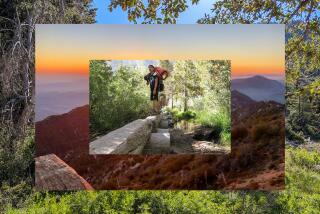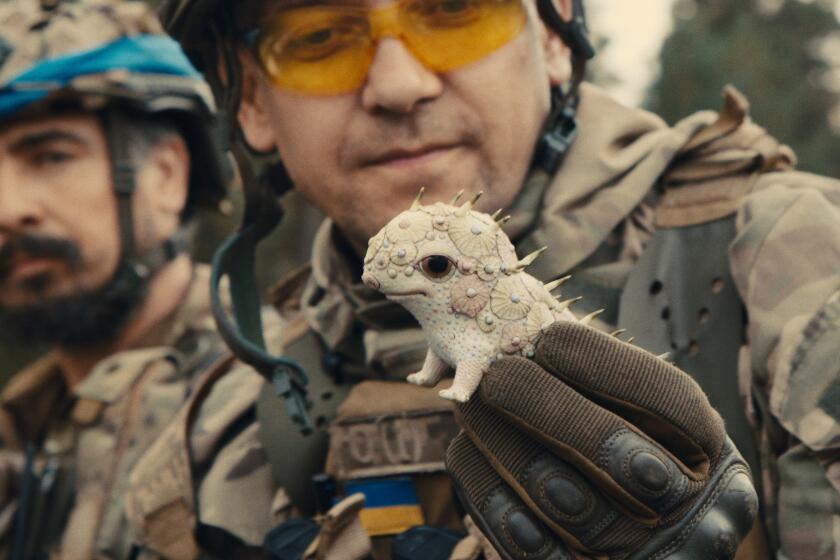The Real-Life Land of Famous Movie Scenes
- Share via
If you look closely, as Dave Holland remembers doing, you can find uncanny similarities in the scenes of many old Hollywood Westerns and action films.
Where Errol Flynn rode in “Charge of the Light Brigade” is also the landscape where John Wayne starred in “Westward Ho.” In “Riders of the Purple Sage,” Tom Mix stalks the same terrain that James Stewart crosses a quarter-century later in “Broken Arrow.” Scenes of Tony Curtis and Jack Lemmon in “The Great Escape” were shot among the same rock formations and passes where Cary Grant labored in “Gunga Din.”
For the record:
12:00 a.m. Sept. 27, 2002 For The Record
Los Angeles Times Friday September 27, 2002 Home Edition Main News Part A Page 2 National Desk 7 inches; 255 words Type of Material: Correction
Surroundings column--The Surroundings column in the California section on Thursday said Tony Curtis and Jack Lemmon appeared in the film “The Great Escape.” The movie was “The Great Race.”
Holland, 67, a retired press agent and assistant director, recalls making the connection many years ago following a conversation with film director John Ford. Their talk inspired Holland to start poring over movie stills.
“Looking at a Gene Autry photo from ‘Boots and Saddles,’ ” Holland later wrote, “I noticed that he and his sidekick ... were sitting their horses by a tall, thick cucumber-shaped rock which was--it was so obvious, it was startling--at the very same spot where the Indian chase in ‘How the West Was Won’ began, and where Tim Holt had tried ditching a posse in one of his RKO pictures called ‘Guns of Hate’! “
That spot was in the Alabama Hills just outside Lone Pine, west of U.S. 395. The area, known as Movie Flats, is a rugged, eerie jumble of granite outcroppings and sloping, brush-covered plains, almost unparalleled for outdoor filmmaking. So far, by Holland’s count, scenes from 312 motion pictures have been shot here, directly beneath Mt. Whitney on the east slope of the Sierra Nevada. Recent footage includes scenes of Russell Crowe in “Gladiator,” as well as alien landscapes used in the multi-part “Star Wars” saga.
“It’s not just cowboy movies,” said Holland, who moved to the hills himself in 1991 and published a 100-page pictorial guide, “On Location in Lone Pine.”
“Alan Ladd was here in the French Foreign Legion [in ‘Desert Legion’]. The cops chased Humphrey Bogart through the Alabama Hills in ‘High Sierra.’ ”
Shooting began in these hills in 1920. A plaque dedicated by Roy Rogers marks the entrance to gravel-covered Movie Road, which winds past scores of shoot locations on land owned by the federal Bureau of Land Management and the Los Angeles Department of Water and Power.
During the Lone Pine Film Festival, scheduled this year for Oct. 11-13, volunteers set up photo markers throughout the hills, allowing visitors to see scenes from movies alongside the natural terrain where they were shot.
You can stand at the spot where the camera filmed Cesar Romero, for example, in 1939, during the making of “Cisco Kid and the Lady.” About 100 such markers bring the landscape to life for hundreds, if not thousands, of movie fans who roll through the hills on tour buses.
Lone Pine’s population of 2,000 more than doubles during the festival, said Director Dorothy Bonnefin. The Lone Pine High School auditorium screens only movies shot here. Fans dress up as Hopalong Cassidy and Buffalo Bill.
“Our Roy Rogers look-alike even brings his palomino horse,” Bonnefin said.
The festival was created in 1990 and has become one of California’s most popular. Many of Movie Flats’ spectacular rock formations are named after old-time stars--Gary Cooper Rock, Lone Ranger Canyon.
Another is being christened this year in honor of actor and World War II hero Audie Murphy, who was here in 1960 to star in “Hell Bent for Leather.”
The rocks are immense, haunting and otherworldly. They rise out of the sloping desert like dark sculptures. Gargantuan mounds of boulders resemble clumps of melted raisins. Tall ridges rise like storm surf, jutting skyward in a froth of craggy rocks rounded by the wind. Smoothly contoured formations give way to serrated spikes. In the jumble and chaos, there are patterns to find.
Lined hemispheres and globes seem to have been fitted together in preformed halves and thirds. Squarish blocks, all tilted slightly to one side, form the face of one immense hill. Rocks are gray, rust-colored, streaked, blackened.
“I swear they’re all animal shapes,” said visitor Anne McAndrews, pointing out a tall series of boulders that resembled a triceratops, and others that looked like reptile scales. “Look at that--that’s a skull. Isn’t that cool? Imagine being out here at night, sleeping, and the shape-shifting that goes on then.”
A two-sided map is available at the Chamber of Commerce. On one side are the rocks’ movie names. On the other are more fanciful monikers: Elephant Rock, the Spooks, Peter’s Pumpkin, Hannibal the Cannibal, Hands from Hades.
“It’s incredible,” Holland said of the area. He goes on at length about the sunrise, the pink light on the Sierra Nevada, the shadows creeping through the boulders.
Brian and Grace Webb built a home on one of the few residential streets in the hills. They are situated among 60-foot boulders, their bedroom facing Mt. Whitney.
“It’s magical,” Brian said.
Sacha Stuart, a former Swiss actress, bought a place 10 years ago surrounded by oversized gardens of rocks. Thunderstorms come in, booming between the Sierra and Inyo mountains, seemingly trapped between the ranges, illuminating granite arches and valleys. The display provides her an answer when people ask why she spends her time in the Alabama Hills.
“I say, ‘That’s where God lives.’ ”
To see video online, go to www.latimes.com/surroundings
More to Read
Only good movies
Get the Indie Focus newsletter, Mark Olsen's weekly guide to the world of cinema.
You may occasionally receive promotional content from the Los Angeles Times.










